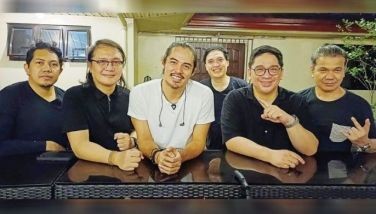Yes, you can judge Dolphy. He's a book!
(Editor’s Note: This article was first published in Filipinas Magazine in 2008, circulated only in the US. The author gave The STAR permission to reprint it.)
Manila, Philippines - 1981. Doro de los Ojos’s wake, at the Funeraria Nacional, along Araneta Avenue. Outside of family, the comics are there: Balot, Don Pepot, Rudy Manlapaz, Palito and Apeng Daldal. I am with two other sitcom writers. We are awed by the personalities, speechless when Dolphy arrives.
He walks in, with Ading Fernando and Conde Ubaldo. They spend a quiet moment by the coffin.
Dolphy chats with the bereaved, inconspicuously hands them a folded envelope, before he faces the rest.
He is in white, from the cap he respectfully took off soon as he entered, down to his shoes. The others are in muted earth colors typically worn on such occasions; the inadvertent color scheme helps identify the leader of the pack, although there is no need for the ID.
The lesser gods encircle him, crack jokes in quick succession, one snappy punchline after the other.
Balot throws in a winner. Dolphy chuckles.
The ice is broken. The atmosphere lightens up with funny anecdotes about the deceased, and laughter rings.
It is a macabre ritual of sorts for the court, done only when an esteemed member passes. Comedy is dead; long live comedy.
The scene remains clear in my mind and I am never able to think of it as the past.
I asked Dolphy about it, in one of our many long afternoons of intense interviews for his autobiography that his son Eric wanted as the first project of the Dolphy Aid Para sa Pinoy Foundation. “Talagang gano’n. Nalulungkot kayo, kasi nalagasan na naman kayo. Gusto n’yong magpatawa para gumaan ang sitwasyon. Pero sino ang mauunang tumawa? (That’s how it usually is. You grieve because one of you has passed on. You want to crack jokes to lighten the situation, but who will be the first to laugh?)
“At the same time, ‘yon ding mauunang tumawa na ‘yon, kailangan, hindi plastic, na tatawa na lang, para masabing o, may natawa na. Dapat, matawa siya sa joke na talagang nakakatawa, e, isipin mo ‘yong puro Aroma boys ang nakapaligid sa iyo, puro trigger-happy magpatawa.” (The first to laugh must not fake it; won’t laugh just for the sake of laughing. One must laugh because the joke is truly funny. Just think, you’re surrounded by the Aroma boys and each one is a trigger-happy jokester.)
Dolphy has not forgotten the Aroma Café in Avenida Rizal, where aspiring comedians used to hang out while waiting for jobs in those pre-television days. When he became a contract star of Sampaguita Pictures, he had to leave (Aroma) to avoid the awkwardness of being seen as still appearing elsewhere.
Yet, he saw to it that he maintained good relations with the Aroma boys. “E, mayro’n do’ng mga lumalabas na, nagta-talent coordinator pa. Nagkaka-pangalan na ako, nare-request sa fiesta, so kukunin nila ako. Makikiusap na isingit ko naman sila sa schedule. Pag kaya, ginagawa ko. Pinagbibigyan ko, pro bono. Mahirap ‘yong hindi ka marunong lumingon sa pinanggalingan.” (Some of them were already hired performers but would still act as talent coordinators. When I was making a name for myself, they would ask me to appear in fiestas. They would request that I accommodate them in my schedule. If I could do it, I would agree to appear for free. It’s not good to forget where you came from.”
And indeed, lumingon sa pinanggalingan is what he does best. For his autobio, he remembers everything in great detail, this major talent who has been part of our lives since Pancho Magalona introduced him to the big bosses of Sampaguita Pictures in 1952, after having been impressed with his comic timing in a live radio show, and his dancing skills, onstage, at the Orient Theater.
I have been a Dolphy fan from way, way back, an avid follower of his radio sitcoms in the early ‘60s, his weekly pre-martial law musical-sitcom hybrid Buhay Artista on ABS-CBN Channel 3 (transferred to Channel 2 in 1969), and the special re-showing of his work from the Sampaguita Pictures’ cache, such as Isang Sulyap Mo Tita, Jack and Jill, Dalagang Ilocana and Hootsy Kootsy, on ABC Channel 5.
His movies, notably the Agent 1-2-3 James Bond spoofs, I caught in double-feature movie houses that cost only P.25 to enter in the ‘60s, bedbug-infested screening rooms that reeked of cigarette smoke and have been long ago demolished: The Rainbow Theater on N. Domingo, facing the San Juan municipio; Embassy, corner Pureza and Sta. Mesa; Cine Moderno, along Bustillos, and Cine Kamuning.
Dolfong Scarface was one such spoof, with a most unlikely theme song in the Dusty Springfield hit, You Don’t Have to Say You Love Me. One of the junior leading ladies was Fil-Am Pamela Ponti, born Alice Smith. With her, Dolphy had four children.
One of the four is Eric, award-winning actor, director and producer. After his two movies and one major telesine with my husband Carlitos and Reyna Films, we became friends, and among other things traveled to film festivals together. It was at the Toronto International Film Festival in 1999, that he first made vague mention about a book on his father. We were both tipsy, so I pretty much dismissed the conversation.
But Eric never really dropped the thought. He’s persevering, which is my politesse for obstinate, very much the Capricorn goat, battering his horns against doors, to get what he wants. Visiting me in the hospital in November 2004, after my mastectomy, he said, “Hoy, ang libro ng Daddy ko! (Hey, don’t forget my dad’s book!)”
Dolphy was much, much kinder when he visited, with a huge box of ensaymada from Hizon’s. I complained about his son, and he smiled, with his trademark twinkling eyes, “Baka naman pinalalakas lang ang loob mo (maybe he just wanted to keep your spirits up).”
It started to get real when we finally sat down for dinner around the second quarter of 2007, at the Le Souffle in Rockwell. I got there first, the place was full, and Eric left instructions for a private corner. One of the floor managers introduced herself: “Hi, I’m Trisha Jimenez, the niece of Tita Luds — Inday Badiday — the daughter of her brother Butch. Would you want a quiet table at the mezzanine?”
With an OK signal from no less than the Queen of Intrigues (as the late Inday Badiday was known), we were off to an auspicious start. I outlined my proposal, how the whole thing was to go. Eric explained the entire procedure was to be captured in video for reference, the video to be transcribed and then sent to me, via e-mail. We yapped for some considerable time, until Rodolfo Vera Quizon spoke.
“Ayaw ko lang na may masaktan. Willing ako na ibunyag lahat, ayaw ko lang na may makapagsabing pati hindi na dapat inungkat, inungkat ko pa. Kung mayro’n man kasi akong nasaktan sa buhay ko, hindi ko sinadya ‘yon. (I don’t want to hurt anyone. I’m willing to reveal everything but I don’t want anybody saying that I revealed something that should’ve remained private. If I had hurt someone in my life, it was never intentional). I never meant to hurt anybody.”
Work commenced late October of the same year and averaged three interview days a week, until February. We stopped only twice, for the Christmas break, and before that, when I got waylaid by the “November 29 incident” at the Manila Peninsula. I was one of those arrested during the military action at the Makati Hotel. Three days after I got out, I was back on the job. His opening line: “O, ‘kosa, laya ka na pala (So, buddy, you’ve been freed).”
The devout Catholic prayed a good 30 minutes before we’d get into business.
Every day, as witnessed by his assistant, Presley, whose mother was so enamored with the original, that she had Presley’s twin named as, uh, Elvis. “E, pag naliligaw raw sila sa mall no’ng maliliit pa sila, at nagsisigaw na’ng nanay nila, tinginan na raw ang lahat (When they were small and would get lost in the mall, their mother would call them and everyone would look),” chortled Dolphy. “Mantakin mo nga naman (just imagine), ‘Elvis! Presley! Elvis! Presley!’”
After each session, he’d ask me out for dinner, taking along whoever offspring was available. The dinners were memorable. He’d inquire about my health, my mother-in-law, my husband, whom he deemed “mukhang mabait (looks like a good guy),” and my children, especially the boy with whom he shared the same birthday, July 25.
He bantered with waiters. Once, after ensuring that our leftovers would go into pabalot (doggie bag) for someone, he ordered for two of partner Zsa Zsa Padilla’s favorite dishes to take home. How he made sure things would go right sounded like a set-up lifted from John en Marsha: “Ayusin n’yo ’ng sistema, ha? Siguruhin ninyong dito sa kasama ko mapunta ang pabalot, at sa akin ang pasalubong. Baka pag-uwi ko, mamura ako ng pasasalubungan ko kung magkapalit at tira-tira ang napunta sa kanya (Make sure you get it right. The leftovers go to my companion here, the new orders are for me. I wouldn’t want to be yelled at for bringing home leftovers)!”
We always got interrupted. Strangers butted in to have pictures taken with him, balikbayans from all over. He didn’t mind. “Taga-saan ho kayo (Where are you from)?” he once inquired of a woman smothering him with kisses.
“Taga-Oregon,” came the reply.
“’Buti na lang, alam ko na kung saan ang Oregon (Good thing, I now know where Oregon is),” he quipped, with characteristic humility.
I found out as much from the dinners, as I did from the straight Q & A.
Despite his misgivings, the book is an absolute tell-all, supported by family album pictures that are coming out for the first time.
There are revelations about his 18 children and their respective mothers. He discusses his failed romances, including the two most well-publicized, with Pilar Pilapil and Lotis Key. Except he does not specifically name any of his “flings.” And is equally reticent with whom he has helped, is still helping and with how much, from the entablado (stage) days, to now that the sitcom is as good as dead. “Huwag na, atin-atin na lang ‘yon (Never mind, that’s just between us).”
He has gentle memories of friends and mentors. He laughs with tearful abandon, recalling Panchito cursing according to the indayog (rhythm) of a Disneyland rollercoaster, or hiding in the men’s room of a nightclub while good, old-fashioned suntukan (fistfight) took place on the dance floor. But he is pained, when he goes into how hard he tried to pretend that the comatose Fernando Poe Jr. he saw in the hospital intensive care unit was merely asleep, that December of 2004.
The story of his life is likewise that of the city of his birth.
He loves his old Manila. He rues values long gone. Freedom from fear. The innocence of youth. Trust in fellow Filipinos. Freedom from want.
“Ang Pilipino noon, taas-noo. Ang taxes niya, alam niyang napupunta sa dapat puntahan. Ang boto niya, talagang binibilang. Ang mga pangarap niya, nakakamtan. Kailan siya ulit maglalakad sa mga kalye ng Manila?” (A Filipino then could hold his head high. He knew his taxes went to where they were supposed to. His vote was actually counted. His dreams could come true. I wonder when [a Filipino] can walk the streets of Manila that proudly again?)
He admits he did not journey alone.
“Sinasabing magaling daw sa drama ang mga comedian. Hindi ko alam kung bakit. Wala akong teorya diyan. Basta from my end, naranasan ko na kasi ang lahat — hirap, gutom, ang mga anak na perhuwisyo’t may bisyo, ang ma-in love, at ang mahiwalay. Napagdaanan ko na’ng lahat, kaya nasasakyan ko kapag ginagampanan ko na (It is said that comedians are good in drama. I don’t know about that, I have no theories to explain that. As for me, I have experienced everything — hardships, hunger, problem children, falling in love and separations. I’ve been through all that so I know how to portray them all).”
It took us close to five months to wrap up. By then, I had begun to appropriate Zsa Zsa’s pet name for him, “Lovey.” We separated with our customary bussing of cheeks, but we punctuated our embrace with a high five. Soon as our palms touched, I knew I was going to miss him.
When Eric the goat told me he wanted a title, I could only come up with his old man’s name.
Dolphy.
Call him King, and he doesn’t like it. Plus, seriously, all else would be pretension.
Dolphy.
(Postscript: After intense discussion between the son/producer and me, the book’s final title is Dolphy: Hindi Ko Ito Narating Mag-isa.)
- Latest
- Trending

































